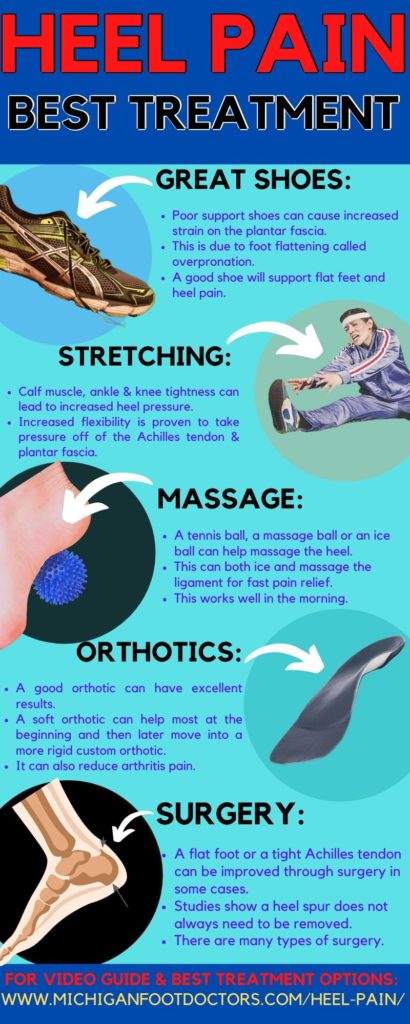Painful Lump in the Arch of My Foot [Exercises & Home Treatment]
The Painful Lump in the Arch of My Foot is most likely #1)Plantar Fibroma & #2) Plantar Fasciitis, but a “pebble-like mass” is usually #3) Fibromatosis!
Lump on bottom of foot arch treatment video:
Lump in arch of foot causes:

Heel Pain Causes: Picture & Photo Gallery
Look:
- One of the top causes of heel pain is plantar fasciitis. This is damage to a ligament that holds your heel to your toes.
- Another root cause of heel pain has flat feet.
- There are also photos of heel spurs that can occur to the bottom of your heel (plantar fascia insertion) and the back of your heel (Achilles tendon insertion).
- Baxter’s nerve entrapment can also happen at the bottom of the heel.
- An underlying cause is an overpronated flatfoot or an over a supinated high arched foot.
- A plantar fibroma is a thick nodule that can occur within your plantar fascia ligament and contribute to plantar fasciitis.
- This can lead to the formation of a heel stress fracture( AKA calcaneus stress fracture.)
Please click on the gallery for a guided tour through heel pain conditions!
Plantar Fibroma Overview:
- The most common cause of this lump is something called a plantar fibroma. This is a big ball of scar tissue-like material.
- The second most common cause is plantar fasciitis.
- The third most common cause can be… many different things!
Causes:
The Painful Lump in the Arch of My Foot: This is one of three potential causes:
Most likely to least likely bottom of the foot lump causes:
Plantar fibroma:
If you can feel a “pebble-like mass,” it is most likely a plantar fibroma:
This is less common but more like a lump than plantar fasciitis is.
- A plantar fibroma is a large nodule of connective tissue that is not dangerous cancer.
- It is a harmless tumor that should pose no risk except irritating the bottom of your foot from pressure.
- If you feel as though the only way the pain will ever get better is to remove the nodule.
- It is possible to decrease this pain greatly, but eventually, surgery may be necessary.
Plantar Fibroma is the most common lump or bumps causing the problem:
- The plantar fascia is a hard connective tissue formation at the bottom of your foot. It can scar and swell into a big thick ball of tissue that feels like a tumor when it sustains damage.
- This can feel like a hard pebble just under your skin if it can range from 2mm to 5 cm!
- We frequently encounter this in our clinic.
- When measured with ultrasound, we can quickly confirm whether it is a fibroma or something else that may be more dangerous.

Plantar Fibroma Treatment:
- If the lump is small, you can treat it as if it were simply plantar fasciitis.
- We have developed a complete four-stage treatment guide that will follow the bottom of your foot pain from the beginning all the way through the end, no matter how far you have to go.
Plantar Fibroma Treatment Guide.
If You Have A Large or Multiple Plantar Fibroma:
Surgery may be the only option:
- If the Lump is large, SURGERY may be the only treatment.
- You should consult an experienced foot doctor or podiatrist as soon as possible to discuss your options.
Plantar Fasciitis:
Most likely due to plantar fasciitis if there is no “pebble-like mass” involved, but instead, the ligament is very sore.
- This is an overuse injury.
- It is from too much stress on the ligament.
- The more your foot flattens, the more you work, the stiffer you are in your legs, the more likely you are to get plantar fasciitis.
Plantar Fasciitis can swell and cause a lump:
- Plantar fasciitis might not always cause a huge lump, but it is the most common arch & heel pain source.
- This can cause your arch ligaments to swell.
- This condition is #1 simply because it is just so common, but it is more of a swollen lump rather than a rock-hard mass.

- The pain is usually concentrated on the inside sole of your foot, extending to your heel.
- It can seem like a lump in the foot sole.
- This pain is due to inflammation & overuse of your foot ligaments.
- Over years and decades, a bone spur can develop from the bottom of your heel.
- If you push hard onto the front of your heel or arch, it will feel painful.
Symptoms:
- Pain in the morning when you wake up.
- Pain after rest.
- Seems like possible lumps on feet with pain.
- The pain usually gets much better after 15-20 minutes of moving around.
- Pain that gets better from anti-inflammatory medication.
- Pain that feels better after massaging the bottom of your foot.
- Pain that gets better after icing your foot with a frozen water bottle.
Plantar Fasciitis Treatment:
Treatment usually consists of:
1)Confirm The Heel Pain 100%:
- Make sure that you have plantar fascitis before you treat it.
- Your podiatrist will be able to help you with this. But this is a prevalent cause of pain in the foot and ankle, probably the most common cause.
- It is especially frustrating to spend time & money treating a condition that you do not have!
2) Stop the Heel Pain:
- Decreasing inflammation is the most critical initial step.
- This is usually very successful at over 90%.
- Once the pain is gone, making sure it stays away is the next step.
- We can jumpstart this process with icing, anti-inflammatories, stretching, and sometimes an injection if the pain is terrible for you.
- You wouldn’t stretch a really injured muscle and work it out right away. You know you need to let it rest first, so treat your fascia the same way!
3) Manage Your Foot Biomechanics & Inflammation:
- Abnormal biomechanics or unusual stress on your foot is usually to blame.
- This means heavyweight, long work hours, less flexibility than when you were a teenager.
- You must control your foot biomechanics:
- This is done through shoe selection, arch control, stretching & strengthening exercises.
- A great pair of over-the-counter orthotics and a perfect shoe will usually be enough to get this done for you!
4)Shockwave therapy for plantar fasciitis:
- We have had great success with shockwave therapy for plantar fasciitis.
5) Invasive Therapy:
- This is usually only needed in 5% of people.
- We rarely ever need to do surgery on your foot unless you have extra stuff going on, like a huge spur.
- Find out if surgery may be needed, shockwave therapy, or injections.
Painful Arch Lump Treatment Guide:
- Over 90% of people can be treated conservatively, according to vast research data.
- So all that is left is to start your treatment!
- Four Stage Treatment Plan
Bottom of the Foot Cancer:
- The only thing to say here is… see your podiatrist!
- Don’t mess around with this.
Foot Lump Cancer, the rarest but most dangerous cause:
- This is very, very rare.
- Usually, you don’t have anything to worry about as these are extremely rare, but there is always comfort in known for sure.
- We would definitely screen it with an ultrasound in our office and possibly even send you for an MRI or perform a tissue biopsy.
- If you are worried, it is better to make 100% sure.
- If you have a hard discrete bump, it is likely a fibroma; but cancer must be ruled out.
Other Minor Causes:
Best Plantar Fibroma Products:
- There are usually two phases to treating plantar fasciitis pain.
- The two phases of treatment include controlling the acute inflammation and correcting the biomechanics, which led to the problem in the first place.
- If the tendons and ligaments are inflamed, they are almost frozen in place and cannot function properly.
- Once the inflammation is decreased, we need to correct the biomechanical causes to ensure that they can never become overworked and inflamed again!
- This doesn’t matter whether it’s plantar fasciitis, plantar fibroma, the sore bottom of the foot, or even Achilles tendon pain. Treatment is all roughly very similar.
Plantar Fibroma Cure & Natural Treatment:
Massage & Ice Products:
- Ice is an excellent option that can be safe for almost everyone.
- There is some debate about whether icing is worth doing, but this can help limit the need for medications and keep your options open for chronic pain.
- This works great for your arch, less for the ball of the foot.
- Manual massage on the plantar fibroma is a natural treatment that can also be considered physical therapy for your plantar fibroma.
- This works to break up the plantar fascia nodule. This works well for small plantar fibroma nodules.
- The more muscle and ligament tissue there is, the better ice will work there.






Menthol Based Gels:
- Biofreeze is one of our favorites.
- These gels have been studied to work 2x as long as ice.
- This works great for the ball of the foot.
- This can be very effective for pain relief, but this will not make the actual nodule disappear.








Massage Sticks:
- These can work great for loosening your muscles.
- This allows less tightness and pressure onto the plantar fascia and heel.
- This is very effective for the arch, the gastrocnemius, calf muscle, and the hamstring and thigh muscles.
- This also works very well for the gluteus muscles if you are having butt cheek or hip pain.
- The massage stick can break up lumps in your plantar fascia and small plantar fibroma nodules.






Remove the Plantar Fascia Stress:
- The key is to prevent future pain stress and trauma to the plantar fibroma nodule.
- This means keeping you active while keeping stress off of your plantar fascia tendon. This will prevent future re-injury and the development of plantar fasciitis.
- If you can get rid of the pain and swelling, this will let you start walking normally.
- If you can walk normally, the vast majority of your pain should gradually start to go away.
- The best way to ensure that your plantar fascia, foot, and ankle ligaments are not overworked is to support them.
- The best way to support them is to use great orthotics and great shoes.
- Some people may also need to rely on supportive ankle braces and other supportive modalities.
Best Shoes for Plantar Fibroma Pain:
- Getting a great supportive pair of plantar fibroma shoes will ensure that there is pressure removed from the heel and plantar fascia region.
- This is especially important if you have plantar fasciitis, heel spur pain, or Achilles tendonitis as well.
- Consider plantar fibroma shoes combined with a good supportive orthotic for best pain relief!
- The following link will show you what our favorites are.
Best Plantar Fibroma Insoles:
- These are our recommended orthotics for plantar fibroma pain.
- Custom orthotics can work very well, but they should not be the first line of treatment due to the cost.
- There are different types of different shoes.
- Women’s shoes usually need a less bulky orthotic but allow for less correction.
- A full-length orthotic requires a running shoe, boot, or comfortable walking/dress shoe.
- We recommend doing everything you can to get a good supportive shoe that can fit a full-length orthotic.
- A further home remedy tip for plantar fibroma pain is cutting out a hole where the nodule uses scissors or a knife. Be careful and start with a very low-cost orthotic.
Click this link for the best podiatrist recommended orthotics!
Best Full-Length Plantar Fibroma Orthotics:
- These will only work in wider shoes or a good supportive running shoe.
- This will not work in sandals, flats, or most women’s dress shoes.








Best Dress Shoe Plantar Fibroma Orthotics:
- These are a great choice for dress orthotics.






Best 3/4 Length Plantar Fibroma Orthotics:
- These are great options for women’s dress shoes and thinner shoes.
- These are not the most supportive pair of orthotics.


Get A Great Dynamic Stretch:
- It is possible to stretch on your own, but these products can also really help!
- This will take pressure off of the ball of your foot.
- This is a form of plantar fibromatosis physical therapy that breaks up the scar tissue.
- We personally prefer this method of stretching.








Get A Great Static Stretch:
- These devices are great for stretching while you are resting.
- This is an excellent plantar fibroma physical therapy routine that you can do at home.
- This will also help take pressure off of the ball of your foot.
- This works great for plantar fasciitis.
- The night splint can be used while watching TV or at night time.






Best Heel Compression Brace:
- A good compression brace can stabilize your foot from turning outward.
- This prevents your foot from pronation.
- The pronated foot will turn your foot outward, in your foot will rub on the outside of the shoe.
- This has solved their pain for many of her patients and is very comfortable to wear inside your shoe.
- This solves both pain and outward pronation for a relatively low cost.




Best Heel Stability Brace:
- The stability brace goes a little bit further than the compression brace to stop your foot from turning out.
- This takes the pressure off of your heel and plantar fascia.
- At the same time, this is a little bit bulkier and does not affect every shoe.
- We find people are a little bit happier trying the compression brace before the stability brace.






Severe Plantar Fibroma Pain:
- If you think you might have a broken heel, a calcaneal stress fracture, or something of similar severity, these products might help!
- Always remember to see a foot and ankle specialist like a podiatrist if you have plantar fasciitis or more severe pain!
Plantar Fascia Tear, Broken Heel Bone, Achilles Tendon Tear:
- If you have a traumatic injury such as a torn plantar fascia ligament, calcaneus stress fracture, heel fracture, or insertional Achilles tendon injury: consider protecting your foot!
- The best way to do this is, of course, to see your podiatrist and get evaluated with an x-ray, ultrasound, and potentially even an MRI or CT scan.
- If you cannot do so, it may benefit you to be in a cast, fractured boot, or even keep the weight off of it with a rolling knee scooter or other protective devices.
- We as podiatrists frequently take patients off work for a very long period of time when they suffer a traumatic injury. Unfortunately, there is no other way around us in labor jobs.
- If you have a sit-down job, there are ways to get people back to work quicker, but this can be impossible otherwise.
Heel Injury Boot Treatment:
- There are pros and cons to using a boot to treat your heel injury. The Pros are that your injured heel will hopefully have a chance to heal gradually! If you are immobilized too long, the cons are that you will gradually become stiff and overworked to your other leg.
- Our favorite fracture boots and their supplies:








Offloading and Scooter treatment:
- These are favorite knee scooters and walking devices.
- If your plantar fibroma pain is severe, offloading can be very effective until the pain calms down.








Best Shoes for a Plantar Fibroma:
Click this link to go over the best shoes for a plantar fibroma!


